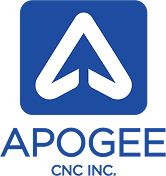Multi-axis machining enables the efficient and scalable production of precision parts that cannot be done with traditional methods.
Traditional 3-axis CNC machines can only move in straight lines along three directions, which makes it hard to create certain shapes or reach some surfaces. Multi-axis machining solves this by adding new types of movement—such as rotating and tilting the part or the cutting tool—which allows access to features like angled holes, curves, or undercuts without stopping for extra setups.
This rotation capability improves surface finish, reduces setup time, and increases consistency across parts. For sectors like aerospace, defense, and high-precision prototyping, where tolerance requirements can be as tight as ±0.0002 inches, multi-axis machining plays a critical role in accelerating the manufacturing process without compromising accuracy.
What Sets Multi-Axis Machining Apart
At its most basic, multi-axis machining enhances how CNC machines move.
A standard 3-axis setup operates along the X, Y, and Z planes. Adding a fourth axis introduces rotation, typically around the X or Y axis, while a fifth axis adds tilt, allowing the tool to approach the part from virtually any angle. This expanded range is essential for accessing hard-to-reach areas and reduces the number of setups required.
Because in multi-axis machining, the tool can move in more ways, the machine can reach and shape detailed features at once. This ability to complete complex cuts in a single setup helps ensure each part is consistent.
When Multi-Axis Makes Sense
Not every project calls for five axes, but certain part designs demand it.
Multi-axis offers significant advantages when a part must be:
- Cut from multiple sides without refixturing
- Machined with deep cavities or undercuts
- Held to extremely tight tolerances across complex surfaces
- Completed quickly to meet aggressive lead times
These capabilities are especially useful during prototyping and low-volume production, where first-pass success is crucial.
The Competitive Edge of Multi-Axis Machining
With fewer setups and faster execution, teams can respond more quickly to last-minute design changes or compressed development timelines. Machinists optimize tool paths, achieve cleaner surface finishes, and scale the process quickly without sacrificing precision.
In practical terms, that means less time to market, fewer rejected parts, and a smoother path from concept to production.
Applying Multi-Axis Capabilities to Your Projects
If your design involves multiple surfaces, deep cavities, or complex angles and precision is essential, multi-axis machining provides the control and flexibility to handle those challenges. It allows intricate parts to be produced efficiently, without the added time or risk that comes with multiple setups.
Have a drawing or model ready? Submit it for review to determine if multi-axis setup is the most efficient path to manufacturing.

